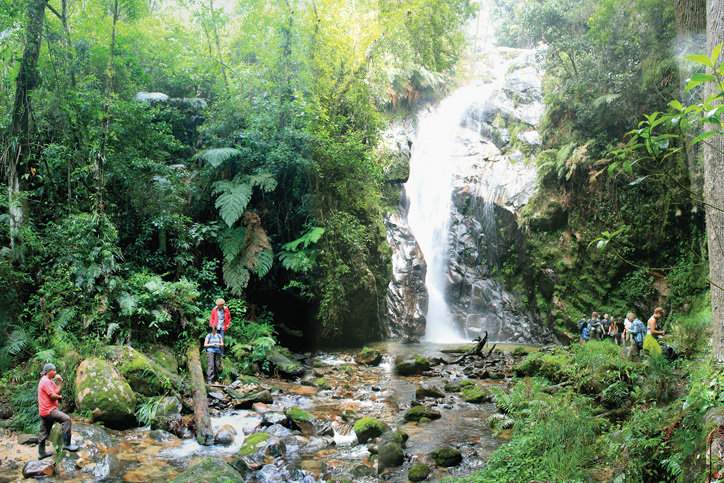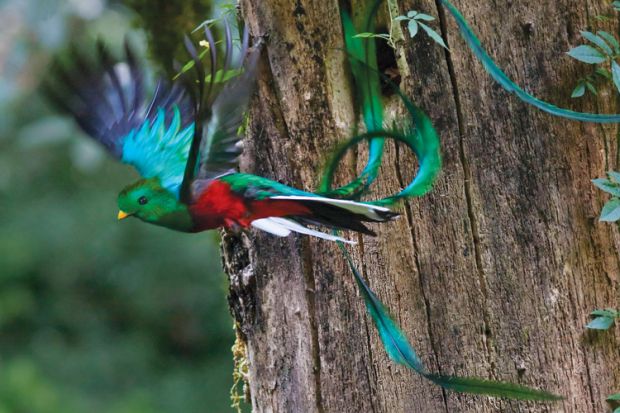As a child, I was captivated by the About Animals volume of the Childcraft encyclopedia, which had a two-page spread on cloud forests. These, I learned, are a special subset of rainforests covering the summits of remote mountain ranges, so high that they are perpetually drenched in cloud. Their isolation makes them some of the most biodiverse places on the planet, with most of their plants and animals found nowhere else. The book contained a photograph of a dark, mysterious jungle of seemingly endless potential discoveries, and I imagined swashbuckling adventures on a quest to see the resplendent quetzal: a breathtakingly iridescent bird depicted on one of the pages, which would beat the socks off any New Guinean bird of paradise in a fashion show.
I now find myself working for one or two months each year in a remote area of the Cusuco National Park in northwest Honduras as one of two senior scientists on site and chief mammalogist for an expedition run by Operation Wallacea, an organisation that brings together networks of academics to monitor biodiversity for the purposes of conservation management.
The popularity of television shows such as I’m a Celebrity…Get Me Out of Here! is based on the Schadenfreude of seeing others exposed to what most people regard as the horrors of the jungle. And certainly there is some unpleasantness. The area where I work has an average slope of about 30 degrees, and torrential rain ensures that every surface is slippery, making traversing the forest exhausting. The region is home to some of the most venomous snakes on earth – fers-de-lance, pit vipers and coral snakes – as well as abundant invertebrates that make even the most jungle-hardened ecologist recoil, including tarantulas, scorpions and, my least favourite, vinegaroons. Last year we had a short spate of tarantula bites when students failed to zip their tents shut.
One of the greatest threats, however, is microscopic. Shigellosis is bacterial diarrhoea accompanied by stomach cramps, fever and vomiting that can last up to seven days. In 2012, on my first visit to Honduras, I was apocalyptically ill one night during an electrical storm. Clambering out of a tent every 10 minutes to trudge through ankle-deep mud in thunder, lightning and torrential rain to evacuate from both ends while running a fever and being so weak that I could barely walk was not pleasant, especially when I failed to zip up the tent and awoke in a near hallucinogenic state to find myself covered in termites. Ever since then, Rule No 1 of the jungle has been: if I start to feel ill, I go straight to the expedition medic for a course of antibiotics.
Medical incidents are not rare, but fortunately most are not life-threatening. Falls, scrapes, bumps and bruises are the most common afflictions. In 2013, I led an excursion to a spectacular waterfall deep within a ravine, where the father of one of the students slipped on a wet rock and broke his leg. My radio was not working, either because we were in such a deep valley that the signal could not be relayed to our base camp or because it had got wet. In temperatures in excess of 30ºC, our local guide was sent to scale the valley wall and bring back a medical team with intravenous morphine and a stretcher. It took more than four hours to evacuate the casualty to the nearest jungle track, from where he was taken to the hospital in San Pedro Sula several hours away. He made a full recovery, but the experience was very stressful for everyone, and I now triple-check every radio before leaving camp.
Natural hazards are not the only perils we face. San Pedro Sula, our base before entering the forest, is listed by the United Nations as one of the most dangerous cities on earth, with 187 murders per 100,000 people each year, mostly associated with street gangs involved in drug trafficking. Some expedition staff members have been mugged for valuables, but no one has ever been hurt.
Yet all this nastiness slips out of mind when I awake to the distant calls of howler monkeys. I emerge from my tent or hammock to fingers of cloud wafting through gigantic cathedral-like trees as 287 bird species make a fresh claim on their patch of forest with a rousing dawn chorus. Camp rules dictate that no one leaves alone – you must always have a local guide and carry a radio, which must remain on at all times. But I will admit to occasionally slipping out, albeit with a radio, to the babbling Río Cusuco, to watch the first golden shafts of morning light penetrate the canopy and descend through the swirling mist as I perch atop a rock dripping with moss and lichens.
In those moments, watching iridescent hummingbirds flit back and forth between freshly opened blooms, I feel as close to spiritual as I ever get. It was in a similar place, deep in the rainforests of Sulawesi in central Indonesia more than 15 years ago, that I first had an epiphany: I realised in a near tangible way that the earth was not here for mankind’s exploitation. Such remote jungles exist for themselves. If I had not been present to watch a spider spin its fresh morning web, it would have made no difference whatsoever. The creature would still be there, as its ancestors have been for millions of years, going about its business cut off from the eyes of man. That’s why I keep going back: to recapture a feeling of isolation far from the rat race and the endlessly depressing media stories of environmental destruction and climate change.

That is not to say that this paradise is safe. Honduras is the second largest yet sixth poorest of the 33 Central American and Caribbean countries; it was ranked 129th out of 187 countries worldwide on the Human Development Index for 2013. Thirty-six per cent of the population has an income of less than $2 (£1.30) a day. That puts the remaining islands of cloud forest at great risk. Exponential population growth in the lowlands means that local people exploit the forest for food, particularly bushmeat, while deforestation provides them with the wood needed to cook.
Walking through the forest on surveys, I have come across illegal hunting platforms in the trees. Hunters perch on them at dawn and dusk, ready to shoot literally anything that walks beneath. They will take large ground birds such as curassows, guans or tinamous, but they are really hoping for a red brocket deer, a white-collared peccary or the greatest prize of all, the endangered Baird’s tapir.
Weighing 400kg, tapirs provide a lot of meat, so the capture of one is a notable event in the life of any village. Looking like a prehistoric cross between a pig and a dwarf elephant, they have prehensile noses for foraging on fallen forest fruits or plucking the best leaves. Baird’s tapirs once roamed from southern Mexico to Colombia, but the animals are now confined to ever-shrinking fragments of forest. Even in Cusuco, more than 1,800m above sea level, they have retreated from the forest edge and are now to be found only in the deep interior of the most remote valleys or mountain ridges, as far from people as they can get. It is in these places that I have been deploying remote cameras that record any animal that moves through their detection beam. These allow me to analyse how many large mammals remain and how they are disturbed by human presence. We have even filmed hunters stalking the national park, looking for their family’s next meal.
And that is precisely what brings me to Honduras. As a member of the Institute for Global Food Security, based at Queen’s University Belfast, I am working to alleviate food insecurity and fuel poverty, liberating local people from reliance on harvesting natural resources unsustainably. Using satellite imagery, we have demonstrated the recent deforestation rate in the region and extrapolated it into the future. We can also calculate the size and density of trees and estimate the carbon content of the forest. Thus, we can demonstrate how much carbon dioxide sequestering capacity will be lost if deforestation is not halted.
If our analysis is accepted by the Natural Forest Standard organisation, international funding equivalent to the market value of carbon credits contained in the forest can be released from the UN’s Reducing Emissions from Deforestation and Forest Degradation (REDD+) programme. This will provide microfinance loans to the local villages for entrepreneurial ventures that will utilise the forest in a sustainable manner, making it valuable beyond its exploitable resources. We hope to invest in bioreactors to decompose maize husks to create heat, further reducing the need for fuel wood.
I come from Ireland, the most deforested region in Europe. Our ancient oak woodlands were cleared for agriculture or for British shipbuilding, and we now have less than 10 per cent woodland cover. Less developed nations have every right to development, growth and progress, and we have zero right to criticise them for exploiting their natural capital. But we do have a responsibility to help them to develop in a way that reduces environmental damage, ensuring the long-term sustainability of the biosphere.
I also work on small mammals, nocturnal creatures that are rarely even glimpsed by visitors to the forest. Back in 2012, we noticed rodents swimming in streams at night when we were out surveying amphibians. After failing to capture any for a couple of years, I realised that we needed to bait our traps with some of the crabs found in the rivers and on the forest floor. Almost instantly, we started catching the elusive water mice. We really cracked it last year, when we exported 10 specimens. It will take a lot more work to formally describe them, but it seems from basic measurements that they belong to the rare genus Rheomys. There are only four species from Mexico to Panama, all to be found in rapidly flowing streams in high-altitude cloud forest. The specimens from Cusuco are two or three times as heavy as any of the other species, yet half the weight of the larger fish- or crab-eating rats found in northern South America. So I am hopeful that the water mouse will turn out to be a mammal species new to science – a very rare discovery, as most furry things are already well described.
And so it is that a native of rural Ireland dreaming of far-off cloud forests now gets to live out his childhood fantasy. I have spent my past four birthdays in the jungle, far from friends and family, so I treat myself on the morning of 22 June by slipping out of camp and going to Las Minas ridge, where the ground falls away and I can watch the resplendent quetzals from my childhood encyclopedia feast on canopy avocados. I still haven’t managed to get a good photo of them, though. I guess I will just have to go back.
Neil Reid is lecturer in conservation biology at the Institute for Global Food Security, Queen’s University Belfast.
POSTSCRIPT:
Print headline: Cloud nine
Register to continue
Why register?
- Registration is free and only takes a moment
- Once registered, you can read 3 articles a month
- Sign up for our newsletter
Subscribe
Or subscribe for unlimited access to:
- Unlimited access to news, views, insights & reviews
- Digital editions
- Digital access to THE’s university and college rankings analysis
Already registered or a current subscriber?




